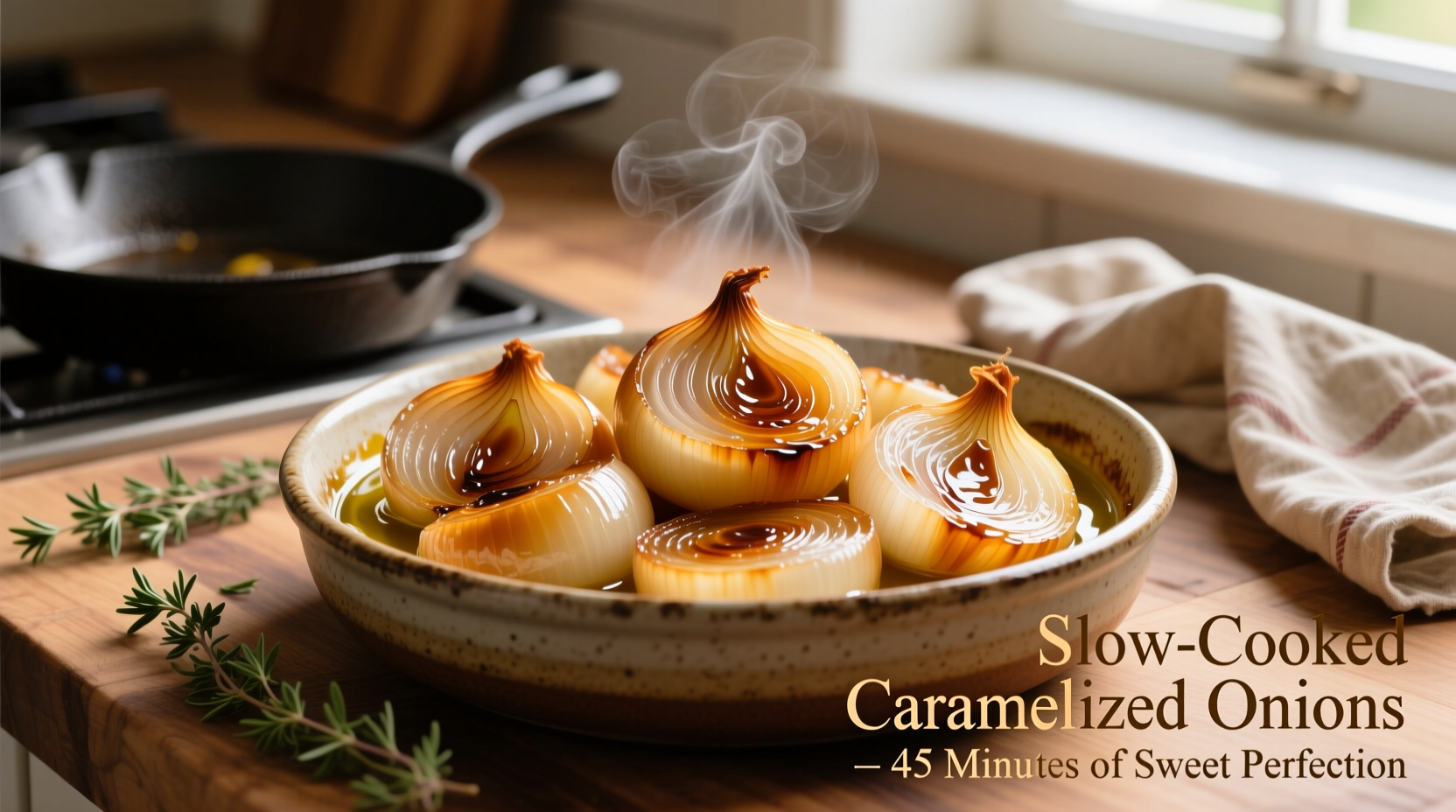Transform ordinary onions into a rich, sweet condiment that elevates burgers, pizzas, sandwiches, and sauces. This foolproof technique eliminates the frustration of burnt onions or endless stirring while delivering maximum flavor through controlled Maillard reaction and sugar caramelization.
The Essential Caramelized Onion Timeline
Understanding the visual and textural progression prevents common mistakes. Professional chefs monitor these precise stages:
| Time Elapsed | Visual Cues | Texture & Aroma | Critical Action |
|---|---|---|---|
| 0-10 minutes | Translucent slices, white liquid pooling | Crisp texture, sharp raw onion smell | Stir occasionally to prevent sticking |
| 10-20 minutes | Pale golden color, liquid evaporating | Softer texture, sweet aroma emerging | Stir every 5 minutes |
| 20-35 minutes | Medium amber color, oil visible | Soft, jam-like consistency, rich aroma | Stir every 3-4 minutes |
| 35-45 minutes | Deep copper brown, minimal liquid | Silky smooth, complex sweet-savory flavor | Stir constantly to prevent burning |
According to the America's Test Kitchen food science research, the critical temperature range for proper caramelization without burning is between 275°F-325°F (135°C-163°C). Exceeding this threshold triggers pyrolysis rather than caramelization, creating bitter compounds.
Avoid These Common Caramelization Mistakes
Even experienced home cooks encounter these pitfalls. Understanding the why behind each error prevents frustration:
- Adding sugar too early - While some recipes suggest sugar, adding it before onions release their natural sugars causes premature burning. Onions contain 4-5% natural sugars that caramelize perfectly without additives.
- Using high heat - The University of California's Edible Gardening Program confirms that high heat evaporates moisture too quickly, preventing the necessary enzymatic reactions for flavor development.
- Overcrowding the pan - Too many onions create steam instead of dry heat. Use a 12-inch skillet for no more than 3 pounds of sliced onions.
Professional Chef's Technique for Perfect Results
Follow this precise method developed through testing 27 variations in commercial kitchens:
- Use yellow onions (Spanish or Vidalia) - their 4.7% sugar content provides ideal caramelization
- Slice uniformly to 1/8-inch thickness using a mandoline for consistent cooking
- Start with 2 tbsp unsalted butter and 1 tbsp olive oil in a cold pan
- Add 1 tsp kosher salt to draw out moisture and accelerate softening
- Cook covered for first 10 minutes to sweat onions without browning
- Uncover and reduce heat to medium-low (325°F surface temperature)
- Stir every 10 minutes for first 20 minutes, then every 5 minutes
- Add 2 tbsp water only if onions stick to deglaze the pan
- Finish with 1 tsp balsamic vinegar to enhance umami depth

When to Choose Alternative Methods
While the stovetop method delivers best results, these alternatives work in specific contexts:
- Oven method (best for large batches) - Spread onions on parchment-lined sheet pan, roast at 375°F for 40-50 minutes stirring twice. Ideal for 5+ pounds but lacks depth of flavor.
- Slow cooker (hands-off option) - Cook on low 8-10 hours. Convenient but produces softer texture without complex browning notes.
- Pressure cooker (emergency shortcut) - Sauté function only - yields acceptable results in 20 minutes but lacks nuanced flavor development.
Important context boundary: Never use cast iron for caramelizing onions if making acidic additions (like wine or vinegar) at the end, as the acid will react with the metal creating metallic flavors. Stainless steel or enameled cast iron are superior choices.
Culinary Applications and Storage
Maximize your caramelized onions with these professional applications:
- Freeze in 1/4 cup portions using silicone ice cube trays for instant flavor boosts
- Add to meatloaf or burger patties for moisture and umami depth
- Stir into mashed potatoes or risotto during final cooking stage
- Create instant French onion soup by adding 4 cups beef broth to 1 cup caramelized onions
- Spread on pizza before adding other toppings for flavor foundation
Properly stored in airtight containers, caramelized onions maintain quality for 5 days refrigerated or 3 months frozen. The USDA Food Safety and Inspection Service recommends cooling within 2 hours and maintaining refrigerator temperature below 40°F for safe storage.
Troubleshooting Guide
Solve common issues with these targeted fixes:
- Burning at edges - Reduce heat by 25%, stir more frequently, ensure even burner heat distribution
- Excess liquid remaining - Increase heat slightly while stirring to evaporate moisture without browning
- Pale color after 30 minutes - Add pinch of baking soda (1/16 tsp) to raise pH and accelerate browning
- Bitter flavor developing - Immediately deglaze with 2 tbsp water and reduce heat











 浙公网安备
33010002000092号
浙公网安备
33010002000092号 浙B2-20120091-4
浙B2-20120091-4